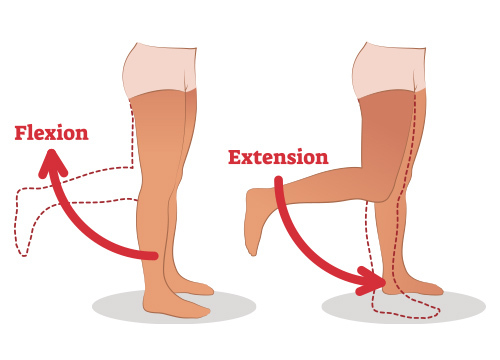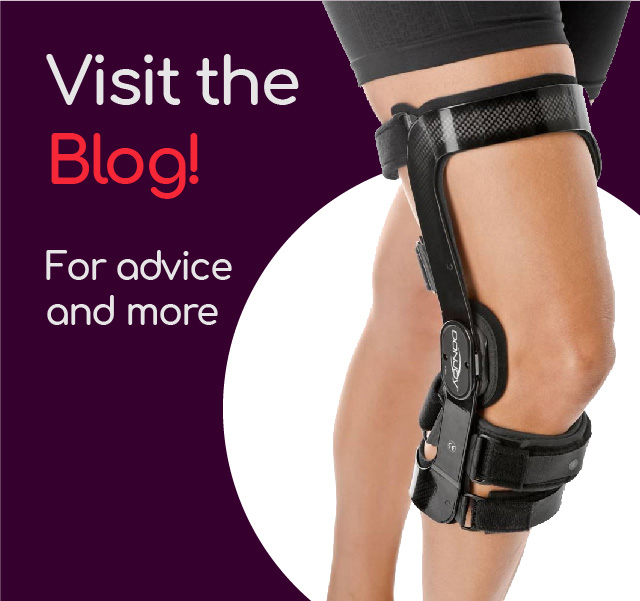Key Terms Glossary
29 July 2022
While exploring our website, you'll likely come across a number of medical terms relating to the knee, and unless you're a practicing orthotist, you may find all this jargon hard to decipher. At KneeSupports.com, we want to make sure you're as informed as possible when making your purchase, so we took the time to list all the key terms in this glossary, with detailed descriptions and definitions for each.
Glossary
Looking for a specific definition? Click the quick-links below to shoot straight to the information you need.

ACL (Anterior Collateral Ligament)
The ACL is a strong band of tissue (ligament) that connects the thigh bone to the shin bone at the knee. This ligament plays an important role in forward-backward motion, and as a result, ACL injuries are one of the most common among competitive athletes. A specially designed offloading brace is the best way to treat such injuries.

Arthritis
Arthritis is the most common knee joint condition, with over 10 million people being affected in the UK alone. There are two main types of arthritis: osteoarthritis and rheumatoid arthritis, which both entail the breakdown of cartilage in the joints, causing dull, aching pain and a loss of stability.

Chondromalacia Patella (Runner's Knee)
Chondromalacia patella is a condition characterised by the breakdown of cartilage on the underside of the knee, causing the kneecap and thigh bone to rub together with painful consequences. This usually occurs as a result of frequent movement and activity, and so is very common among runners and other athletes (hence the nickname "runner's knee").

Compression
Compression is the technique of placing pressure on an area to improve proprioception and encourage blood circulation. Many of our knee supports are compressive, meaning they press intently around the knee to relieve pain and increase your ability to sense movement.

Effusion
Effusion is a medical term that refers to the accumulation of fluid within an anatomic space, such as in or around the knee joint. Knee effusions can be caused by arthritis, or by an injury to the ligaments or meniscus. Effusion is different to an oedema, which refers to trapped excess liquid inside the body tissue.

Extension
Extension is the forward motion of the knee that occurs during functional movements such as walking, climbing stairs or jumping. Virtually all functional activities require full extension of the knee at one moment. Overextension is where the knee has gone beyond full extension, resulting in potential damage and instability.

Flexion
Flexion is the backwards motion of the knee that occurs during functional movements such as walking, climbing stairs or jumping. Most functional activities require up to 120° of flexion, however, full flexion can extend up to 135°. Hyperflexion occurs when the knee joint goes beyond this normal range of motion, potentially causing injury.


Gonarthrosis
Gonarthrosis is a medical term that relates to osteoarthritis specifically inside the knee joint. This condition is usually caused by age-related wear of the cartilage in the knee, resulting in pain, inflammation and increased difficulty moving. Our range of OA knee supports are designed to help people live comfortably with this disease.

Hyperextension
Hyperextension of the knee occurs when the joint moves excessively in the wrong direction, usually when straightened too fast or forcefully during high-impact sports. To treat hyperextension, range of motion hinges are needed to prevent the knee from overextending.

Instability
Knee instability often occurs after a traumatic injury, or when a long-term chronic issue has caused degeneration of the knee. Instability can feel as though the kneecap is twisting or sliding from side to side when doing basic movements. Hinged or strapping knee supports are often the best bet for treating instability.

Oedema
An oedema is swelling caused by an excess of trapped liquid within your body's tissue. Injuries to the knee or inflammatory conditions such as arthritis can cause this excess fluid to collect around the kneecap, causing pain and incresed difficulty to move. An oedema is different to effusion, which refers to the build-up of fluids around an anatomic space (i.e. joints).

Offloading
Offloading is a method in which weight and pressure is moved from the painful side of the knee to the healthy. Most effective for arthritis pain or ligament injuries, offloading braces use special hinge systems which can effectively remove pain simply by shifting your weight.

Orthoses
Orthoses are external medical devices which are used to support, immobilise or treat areas of the body that have been injured, weakened or deformed. Knee supports, braces and splints all classify as orthoses.

Orthotics
Orthotics refers to a special field of medicine which deals in the making, provision and use of artificial braces, splints and supports (collectively known as orthoses) for injured or weakened body parts.

Orthotist
An orthotist refers to a healthcare practitioner who specialises in the making and fitting of braces, splints and supports (orthoses). Orthotists are experts who can identify what type of brace is best for each individual person and condition.

Osgood-Schlatter
This condition can cause a great deal of pain and swelling around the patella tendon, caused by the tendon becoming attached to the tibia (shinbone). Osgood-Schlatter's disease mostly affects young, athletic individuals between the ages of 10 and 15. Treatments include icing, anti-inflammatory medication, and patella tendon supports.

Patella
The patella, more commonly known as the kneecap, is a small bone located at the meeting point between the thighbone and shinbone (femur and tibia). It's main job is to protect the knee and connect the thigh and calf muscles, but because of its location, it can undergo a lot of strain and pressure on a daily basis.

Popliteal
This refers to the diamond shaped area at the very back of the knee. Many of our braces provide extra stretch in this area for greater comfort and flexibility.

Proprioception
This refers to the body's own ability to sense movement, action and location. Proprioceptive awareness is a natural instinct that allows you to move around without consciously thinking about each and every step. Compressive knee supports help improve this natural ability by making those with weak joints more aware of their movement, in turn reducing their risk of injury.

Rheumatism
Rheumatism, or rheumatoid arthritis, is a rarer and longer-term form of arthritis whereby the body's immune system attacks the cartilage in the joints, causing the same painful effects of osteoarthritis. Unlike other forms of arthritis, rheumatism can affect people of any age, causing a significant impact on quality of life.

ROM (Range of Motion)
ROM refers to how far you can bend or stretch a certain part of your body. Some of our knee supports are designed to restrict the range of motion at certain points to help prevent injury aggravation, with adjustment settings so the ROM can be increased or decreased whenever necessary.

Subluxation
A subluxation is a partial dislocation of a joint in the body, which although less serious, can still cause considerable amounts of pain and discomfort. Thankfully, they are general more easy to treat, usually by manipulating the joint so that it returns to its normal alignment. Knee subluxations can be corrected through physiotherapy, which can be supplemented with patella tracking knee braces.

Tendonitis
Tendonitis is a common condition that refers to inflammation of a tendon, often following an injury. Patella tendonitis (also known as Jumper's knee) is one of the most common causes of knee pain, especially among athletes who frequently run, jump or kick. For this condition, we recommend patella straps to help ease pain and tension on the tendon.

Inform Your Purchase
We hope this article has helped break down some tricky terms in ways that are easy to understand. Now that you're fully prepared to make a well informed knee brace purchase, feel free to explore our comprehensive range of knee supports, suitable for a wide range of conditions, uses and budgets.
Please feel free to keep this tab open, and refer back as often as you need while browsing through our range.










